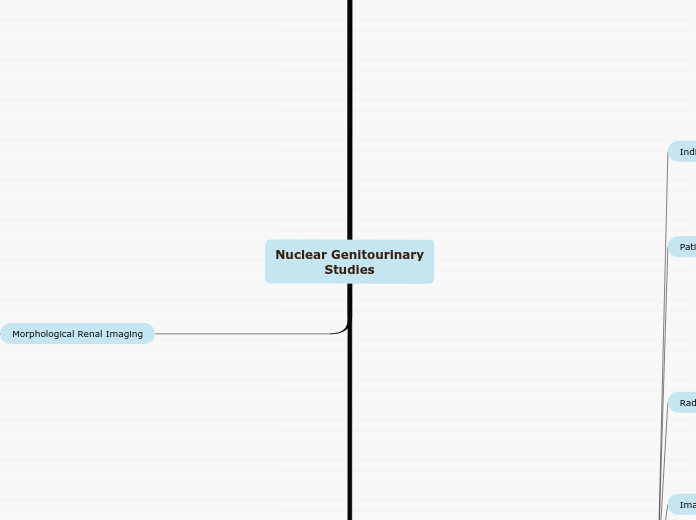door Lauren Barnett 4 jaren geleden
236
Nuclear Genitourinary Studies

door Lauren Barnett 4 jaren geleden
236

Meer zoals dit
activity in upper urinary tracts during filling, at full capacity, and/or while voiding
all or nearly all solution voided from bladder
no reflux visualized
residual bladder volume [ml]= voided volume [ml] x residual counts/min
Divided by max counts/min - residual counts/min
measure urine output
deflate foley and have patient void
place patient sitting on potty chair with camera posterior
Take 120 second immediate post void static and record CPM
once bladder is full, take 120 second immediate statics of posterior and L/R posterior obliques
monitor p-scope for signs of reflux (any activity above the bladder)
if reflux is seen, record amount of saline was infused at that time
fill until drip slows or voids around catheter
fill bladder to max capacity (age + 2) x 30 =volume instill [ml]
sitting or supine
bladder and kidneys in FOV
Critical organ: bladder (18-27 mrads/mCi)
indwelling bladder catheter
inflate, balloon, tape to secure
aseptic technique
Pre void and post void images of kidney and bladder
Lasix
Administer over 1-2 minutes by IV at 20 minutes
note frame number at time of administration
Dynamic
1-2 minutes/frame 20-30 minutes
Flow
30 frames x 2 seconds/frame
Generate Time Activity Curve
See Functional Renal Imaging
Pediatric dose: 1 mg/kg (Max 40 mg)
Dose: 20-80mg I.V.
Differentiate column of Bertin from mass
uptake in the column of Bertin, but not in a mass caused by tumor
Acute pyelonephritis
single or multiple defects resulting in decreased uptake
equal distribution in each kidney
smooth renal contour
Static images
Posterior/ RAO/LAO/RPO/LPO with kidney in center of FOV
2 hours post injection
Images
Data Acquisition
140 keV, 20% winodw
500k counts for each image
5 images total
LFOV gamma camera
SPECT: single, dual or triple head
Pinhole collimator for cortical images
prone preferred
parallel hole collimator for differential calculation
include kidneys and bladder
void before imaging
Permits visualization of renal blood flow and imaging of the renal cortex
Secreted by Glomerular filtration and tubular secretion
Renal clearance is approximately 50% at 3 hours
Must be stored in the refrigerator
Child: 200 uCi/kg
Adult: 10-15 mCi
Intravenous
Child: 50uCi/kg
Webster's rule for pediatric dose: [age + 1] / [Age + 7] x adult dose
Adult: 5 mCi
10 mCI will give a higher dosimetry dose, but gives better image quality due to increased counts
25-50% of dose is in kidney in 1 hour and increases with time
Approx 16% will be in the urine in 3 hours after inj.
Taken up by renal cortex (proximal convoluted tubule) MOL tubular binding
90% binds to plasma proteins, preventing significant glomerular filtration
Tc99m dimercaptosuccinic
7 RADS to the renal cortex
Highest patient radiation dose of all renal imaging agents
not an absolute, risk-to-benefit ratio must be considered
pyelonephritis is usually results from reflux of infected urine
Kidney Function decrease
Time to Peak activity decrease
prolonged renal parenchymal transit
Decreased renal uptake in one or both kidneys
ROI's
Background subtraction
cortical regions of the kidneys
Renogram Curve Analysis
Full FOV
Single or dual head camera
Posterior imaging
Obtain pre-void and post-void images
suspected ureteral obstruction
Serial Dynamic images
1-2 minutes/frame
20-30 minutes
Flow: Dynamic Acquisition
2-4 seconds/frame
60-120 seconds
Monitor patients blood pressure before administration of ACE inhibitor and every 15 minutes after for 1 hour
monitoring for hypotension
Void before imaging
4 hours fasting
Dose: 40ug/kg
I.V. over 3-5 minutes
Given 1 hour before injection of radiopharmaceutical
Dose: 50mg
Pediatric dose: 0.5 mg/kg
Maximum: 25mg
P.O.
Crushed and dissolved in water
Energy: 140 keV
Target Organ: Kindeys
Critical Organ: Bladder Wall
Target Organ: Kidneys
Pediatric: 0.15 mCi/kg
Maximum: 4mCi
Minimum: 1mCi
Adult: 5-10 mCi I.V.
Abnormal
asymmetric
retention of activity in the kidneys
Normal
reasonably symmetric
kidney activity peaking at 3-5 minutes and decreased to less than 50% by 20 minutes
Quantitative analysis - relative renal function
ROI's drawn around kidneys, abdominal aorta and background
LEAP collimator
Full FOV for adults
Zoom FOV for pediatrics
Single or dual head gamma camera
Anterior imaging for renal transplants
Posterior imaging for native kidneys
TOTAL TIME: 22 MINUTES
Post Void: Posterior static acquisition
2 minutes
Function: Dynamic acquisition
19 minutes of 20 s/frame; compressed to 1 min/frame
Flow: Dynamic acquisition
30 frames x 2 s/frame
Use dose to mark sternal notch in top 1/3 of image and bladder in bottom 1/3 of image. Use dose to ensure patients left and right sides are in the image
Supine
Bladder emptied immediately before imaging
140 keV
Pediatric: 100 uCi/kg
Minimum 1 mCi
Functional, effective renal plasma flow agent
MOL: Tubular reabsorption/Glomerular filtration
Target organ: Kidneys
Critical organ: Bladder
Dose
Pediatric: 200 uCi/kg
Minimum 2 mCi
Adult: 10-20 mCi
Functional glomerular agent
MOL: Glomerular filtration
Large antecubital vein preferred
Intravenous, bolus